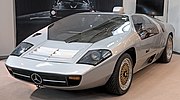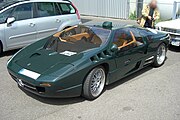Isdera Imperator 108i
| Isdera Imperator 108i | |
|---|---|
 | |
| Overview | |
| Manufacturer | Isdera GmBH |
| Production | 1984–1993 30 units produced[1][2] |
| Assembly | Leonberg, Germany |
| Designer | Eberhard Schulz[3][1] |
| Body and chassis | |
| Class | Sports car (S) |
| Body style | 2-door coupé |
| Layout | Rear mid-engine, rear wheel drive |
| Platform | Fibreglass body over tubular steel chassis |
| Related | Mercedes-Benz CW311[4][2] |
| Powertrain | |
| Engine |
|
| Transmission | 5-speed ZF manual |
| Dimensions | |
| Wheelbase | 2,480 mm (98 in)[5] |
| Length | 4,220 mm (166 in)[5] |
| Width | 1,835 mm (72 in)[5] |
| Height | 1,135 mm (45 in)[5] |
| Curb weight | 1,250 kg (2,756 lb)[5] |
| Chronology | |
| Predecessor | Isdera Spyder 033 |
| Successor | Isdera Commendatore 112i |
The Isdera Imperator 108i is a low-volume German sports car produced from 1984 to 1993. The Imperator 108i was born out of the Mercedes-Benz CW311 concept car from 1978, which Eberhard Schulz, who at the time worked as a design engineer for Porsche, designed in his free time. Mercedes-Benz had no interest in putting the CW311 into production, so Schulz established his own engineering company, Isdera, to produce the car under his own brand.[6][7][3][2] Isdera AG owns the trademarks to Imperator as separate brand.
Specifications and performance
[edit]Implementing a fiberglass body upon a tubular steel spaceframe, the Isdera Imperator 108i was comparable to the exotic sports cars of its day. Little was changed from the original Mercedes-Benz show car with the most noticeable changes being the replacement of the pop-up headlights with two fixed units and more conventional tail lights sourced from Mercedes-Benz. The original Imperator 108i featured a 5.0 L (5,000 cc) Mercedes-Benz M117 V8 engine which gave the vehicle a top speed of 283 km/h (176 mph) and a 0–97 km/h (0–60 mph) acceleration time of 5.0 seconds. As Mercedes-Benz developed more powerful V8 engines, they were used in the Imperator 108i. Later engines included a 5.6 L (5,600 cc) Mercedes-Benz M117 V8, a 5.6 L (5,600 cc) AMG V8 and a 6.0 L (6,000 cc) AMG V8 which saw an eventual increase of power from 300 hp (304 PS; 224 kW) to 390 hp (395 PS; 291 kW), with both AMG engines featuring advanced 32-valve cylinder heads.[3][8]
Unusually, the Imperator 108i featured a rear-view periscope in place of conventional rear view mirrors which gave the driver the rear view, creating a bulge on the roof. It also featured gullwing doors.[3][1]
Inside, the car featured a luxurious interior and sourced many interior components from the Porsche 928.[1][2][8]
Production
[edit]Introduction
[edit]The Imperator 108i was first unveiled to public at the Geneva International Motor Show in March 1984.[a][9]
Model year changes
[edit]In 1991, the car received a face-lift which saw the return of the pop-up headlamps from the 1978 show car and a more curvaceous body shape, additional vents at the front near the doors, NACA duct on the front in place of three vents, redesigned front grille and repositioning of turning indicators from the front grille to the bottom of the headlamps along with optional wing mirrors. Around 17 cars were produced with the face lift design.[5][1]
End of production
[edit]Production ended in 1993, when the Isdera company itself went out of business. Total of thirty examples produced, of which 24 were the pre-facelift models. Reportedly, two of these thirty Imperator 108i were exported to Japan.[10][2][3]
Gallery
[edit]Notes
[edit]- ^ The Geneva International Motor Show has been held annually every March.
References
[edit]- ^ a b c d e Berg, Nik (March 23, 2021). "This Isdera Imperator came, saw, and conquered 1991". Hagerty. Hagerty. Retrieved December 10, 2024.
- ^ a b c d e Rong, Blake Z. (May 28, 2016). "The Isdera Imperator 108i is a Mercedes-Benz Wedge From The Future". Road & Track. Retrieved December 10, 2024.
- ^ a b c d e Lawrence, Mike (1996). A to Z of Sports Cars, 1945-1990. Bay View Books. ISBN 9781870979818.
ISDERA (D)
The Isdera Imperator 108i was the creation of Eberhard Schulz, who had been an associate of Rainer Buchmann at b+b (qv) when he had created the b+b CW311. It was not surprising, then, that the Imperator was fairly close to that car and even used the periscope which replaced the more usual rear view mirror. The customer originally had a choice of Mercedes-Benz or Porsche V8 engines which promised the 0-60mph sprint in under five seconds. By 1990 the specification had settled and Mercedes-Benz engines, ranging from 3 to 6 litres, were offered in a tubular frame with independent suspension all round by coil springs and double wishbones. Bodies were of fibreglass. A Spyder version with a high T-bar and fussy styling behind it had presence but not, perhaps, line. By 1990 total production had reached about 24 each of the Spyder and Imperator. - ^ "The mystery Merc you've never heard of". classicandsportscar.com. Retrieved January 15, 2022.
- ^ a b c d e f Wouter Melissen (21 July 2015). "Isdera Imperator 108i specifications". Retrieved 19 February 2018.
- ^ Melissen, Wouter (21 July 2015). "Isdera Imperator 108i". Retrieved 8 July 2018.
- ^ Kuah, Ian (1986). Fantasy Cars: A Selection of the World's Most Desirable Automobiles. Longmeadow Press. p. 95. ISBN 9780681400467.
- ^ a b Helander, Benjamin (June 14, 2023). "Nimi muutettu: Isdera Imperator 108i – hylätystä Mercedes-Benz -konseptista harvinaiseksi tuotantoautoksi" [Name changed: Isdera Imperator 108i – from abandoned Mercedes-Benz concept to rare production car]. Moottori.fi (in Finnish). Retrieved December 10, 2024.
- ^ Johnson, Davey G. (June 9, 2016). "Down Periscope: Isdera Imperator 108i for Sale!". Car and Driver. Retrieved December 11, 2024.
Schulz founded Isdera in 1981, swapped the old M100 for the then current 235-hp M117 5.0-liter V-8, and launched the Imperator at the Geneva auto show in 1984.
- ^ "1991 Isdera Imperator 108i Mercedes Gullwing". German Cars For Sale Blog. 24 March 2010. Retrieved 14 March 2012.



